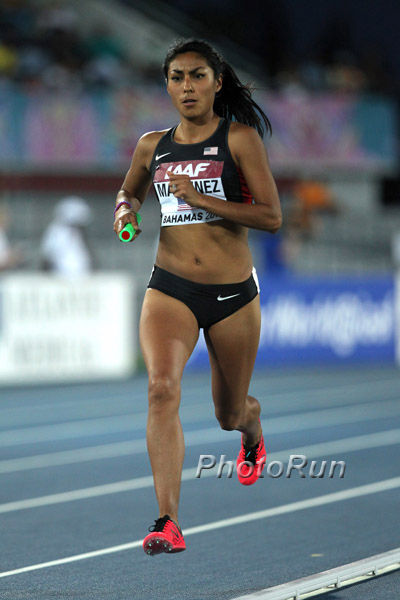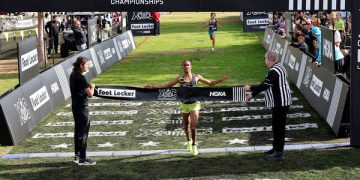
Brenda Martinez, photo by PhotoRun.net
The World Relays are a success in the first year. This is a no-brainer. But, kind reader, why should the sport embrace this type of event? How do we grow the sport back into the splendor of old with the view from a changed world? Here are some modest suggestions!
It is Monday morning, and the clouds are out. The World Relays are over and I feel like I have been three Keith Richards binge. What I mean by that, is even thought I no longer consume alcohol, the long hours, the busy days and nights catch up. So, after one more column today, I am shutting down the computer for a bit, going to the beach and reading poorly translated Chinese science fiction with a political twist.
The World Relays to me, were a great success. Here is why:
The IAAF needs to innovate, and share the global benefits of the sport. The Caribbean is a great place to be, outside of the US, Europe and Asia, and the event was perfectly situated. Relays are the lifeblood of the Bahamas. In this country with 700 islands and 350,000 people, they have had 27 World Championship and Olympic medals, almost all the medals being from relays.
The new Thomas A. Robinson stadium, built as part of an agreement between the government of the Bahamas, the Ministry of Sport and a new Chinese hotel and casino venture, was the focus of much scrutiny in the Bahamas. How could they ever fill the place up?
Well, nine months ago, they came up with an idea. That was when the local Federation, and LOC came together to make this event a reality. Nine months! Only one meet has ever been held in the stadium, the CARIFTA games and the track has been rebuilt three times.
The new MONDO track is fast, furious and beautiful. I heard one suggestion: Why not have it in the colors of the Bahamas? Alas, there was too little time this go around, but MONDO did a fine job and this track should be in all of their ad promotions
Forty teams and 500 athletes. I believe many teams came here wondering what they were running-was this an ersatz Penn Relays or was this a championship. WC 200m silver medalist now manager John Regis said it best. Mr. Regis noted that the competition was championship level and that it will mean teams next year are at an even higher level. But John Regis made an even bigger point-he noted that this is fine sports entertainment.
If the IAAF wants to take the sport of athletics to a higher level, events like this, are made for TV. Don’t play with Universal in the U.S, which is seen by less than half of the country, get it on ESPN, ESPN 2. It is key that terrestrial TV not be ignored and that the streaming video, such as USATF.tv be done at the same time.
There is an anecdote about the late Primo Nebiolo, former President of the IAAF. It is said that, in exhausting negotiations with an unnamed cable group, Nebiolo broke off negotiations and put out a news release that all athletics TV would go to free for all members. The cable group nearly had a stroke and gave Monsieur President his money.
In the late 1950s, as the NFL was really starting to catch on, games were $1.50 for cheap tickets. It captured a generation, plus its accessibility to TV.
For some reason, we missed that with our sport. We went from a major to a major minor to a historic minor who has, now, for the first time in years, major possibilities. Our sport’s embracing of the digital and social world is second to none. Alan Abrahamson, one of global sports worlds most critical thinkers, gave the IAAF kudos not only on the Relays, but also, on their embracing of the digital world
(http://www.3wiresports.com/2014/05/23/relay-box-thinkers/).
The World Relays have a home, I believe, in The Bahamas. With the right support, and the amazing venue, this event is an example of combining world class competition and sports entertainment. An event that can be loved by track geeks and the short attention span of the generic sports fan. It is NASCAR meets track & field. Get the baton around the track without dropping it, or going out of exchange zones. Pretty simple, harder to do at 20 plus miles an hour!
Larry Eder has had a 52-year involvement in the sport of athletics. Larry has experienced the sport as an athlete, coach, magazine publisher, and now, journalist and blogger. His first article, on Don Bowden, America's first sub-4 minute miler, was published in RW in 1983. Larry has published several magazines on athletics, from American Athletics to the U.S. version of Spikes magazine. He currently manages the content and marketing development of the RunningNetwork, The Shoe Addicts, and RunBlogRun. Of RunBlogRun, his daily pilgrimage with the sport, Larry says: "I have to admit, I love traveling to far away meets, writing about the sport I love, and the athletes I respect, for my readers at runblogrun.com, the most of anything I have ever done, except, maybe running itself." Also does some updates for BBC Sports at key events, which he truly enjoys. Theme song: Greg Allman, " I'm no Angel."
View all posts






















